| Listing 1 - 10 of 52 | << page >> |
Sort by
|
Book
ISBN: 9780123942791 0123942799 Year: 2012 Volume: 63 Publisher: Amsterdam: Elsevier,
Abstract | Keywords | Export | Availability | Bookmark
 Loading...
Loading...Choose an application
- Reference Manager
- EndNote
- RefWorks (Direct export to RefWorks)
576.311.347 --- 575.113 --- 575.113 Gene. Genetic apparatus. Genome --- Gene. Genetic apparatus. Genome --- 576.311.347 Mitochondria --- Mitochondria
Dissertation
ISBN: 8798687204 Year: 1997 Publisher: Copenhagen : Royal veterinary and agricultural university,
Abstract | Keywords | Export | Availability | Bookmark
 Loading...
Loading...Choose an application
- Reference Manager
- EndNote
- RefWorks (Direct export to RefWorks)
575.113 --- 636.4 --- 636.4 Pigs. Swine --- Pigs. Swine --- 575.113 Gene. Genetic apparatus. Genome --- Gene. Genetic apparatus. Genome --- Theses --- Genes. --- Genetic code. --- Genome --- Animal.
Dissertation
ISBN: 9789086492411 Year: 2009 Publisher: Leuven Katholieke Universiteit Leuven. Faculteit Wetenschappen
Abstract | Keywords | Export | Availability | Bookmark
 Loading...
Loading...Choose an application
- Reference Manager
- EndNote
- RefWorks (Direct export to RefWorks)
De zeebaars ( Dicentrarchus labrax ) is economisch gezien een belangrijke vissoort voor de Europese aquacultuur. Hoewel de genetische populatiestructuur goed gekend is, haalt de aquacultuur weinig voordeel uit selectieprogramma’s. De zeebaarsproductie is nagenoeg volledig gebaseerd op de reproductie van wildvang in semi-gecontroleerde omstandigheden. Meer kennis van het zeebaarsgenoom zou zowel de kweek, de kennis van de evolutie van natuurlijke populaties en het visserijbeheer ten goede komen. De ontwikkeling van grote bestanden aan Expressed Sequence Tags (ESTs) is een hulpmiddel geworden om nieuwe genen en merkers te ontdekken, de grenzen tussen intronen en exonen te identificeren en genexpressie profielen te karakteriseren. In dit doctoraat gaat de aandacht naar de ontdekking van Single Nucleotide Polymorphismen (SNP) gelegen in ESTs. SNPs zijn de grootste bron van variatie in eu- en prokaryote genomen en hebben toepassingen zowel in de aquacultuur als natuurlijke populaties. Om en bij de 30.000 ESTs afkomstig van 14 weefselbibliotheken van vijf zeebaarzen werden gesequeneerd. Deze EST collectie werd beschreven en vergeleken met een gelijkaardig geheel van ESTs van zeebrasem ( Sparus aurata ), eveneens een economisch belangrijke soort (Hoofdstuk 1). De verwerking van deze ESTs leidde tot de ontwikkeling van 17,716 en 18,198 unieke sequenties voor zeebaars en zeebrasem respectievelijk, waarvan minder dan één derde gemeenschappelijk waren aan beide soorten. Automatische annotatie toonde aan dat voor zeebaars meer eiwit coderende sequenties ontdekt werden dan voor zeebrasem. Dit werd tevens bevestigd door de voorspelling van Open Reading Frames (ORFs) en door de GC inhoud van unieke zeebaars en zeebrasem sequenties. Gene Ontology (GO) annotatie toonde aan dat voor beide soorten dezelfde categorieën aanwezig waren. Zes SNP ontdekkingsinstrumenten werden gebruikt voor de ESTs van zeebaars; hun performantie werd bepaald door het valideren van ongeveer 10% van de SNP kandidaten (Hoofdstuk 2). De analyse toonde aan dat de selectie van overtalrijke SNP kandidaten (foute paringen die minstens tweemaal gedetecteerd werden in de ESTs) een goede manier was om de SNP ontdekkingsperformantie te verbeteren. De selectie van SNP kandidaten met een minimale allelfrekwentie groter dan of gelijk aan 0,3 versterkte de SNP ontdekkingsperformantie, ondanks de vermindering van het aantal SNP kandidaten. Tenslotte was de selectie van SNP kandidaten die gedetecteerd werden door verschillende instrumenten en de uitsluiting van indels een goede manier om het aantal vals positieve SNP kandidaten te verkleinen. Transitie SNP kandidaten bleken minder betrouwbaar te zijn dan transversie SNP kandidaten door de aanwezigheid van RNA editeerbare sites in EST collecties. De hoge kwaliteit van de EST samenvoeging en de flankerende gebieden van SNP kandidaten bleken essentieel voor een efficiënte SNP ontdekking. Deze conclusies gaven aanleiding tot de ontwikkeling van een pijplijn die de zes geteste SNP ontwikkelingsinstrumenten integreerde (Hoofdstuk 3). Deze efficiënte en eenvoudig bruikbare pijplijn laat toe SNPs in een willekeurige EST dataset te detecteren, SNP kandidaten volgens hun redundantie en/of minimum allelfrekwentie te selecteren en SNP kandidaten volgens het SNP ontdekkingsinstrument te vergelijken. Dit werd succesvol toegepast op EST collecties van de vissoorten Dicentrarchus labrax , Sparus aurata , Anguilla anguilla en de watervlo Daphnia magna . Door middel van de zes SNP ontdekkingsinstrumenten werden 1072 unieke SNP kandidaten geïdentificeerd waarvan een subset werd gevalideerd (Hoofdstuk 4). In totaal 360 SNPs werd ontdekt in intronen en ESTs, wat aantoonde dat herbepaling van de sequentie van de contigs die voorspeld werden als polymorf een efficiënte manier was om SNPs te ontdekken. De nucleotidendiversiteit van zeebaars werd geschat op één SNP per 137 basenparen; de waarde was hoger in intronen dan in ESTs. De Mendeliaanse overerfbaarheid werd nagekeken voor 17 SNPs, allen polymorf in de VeneziaFbis familie en gebruikt om een koppelingskaart van zeebaars te maken. Vier SNPs werden niet Mendeliaans overgeërfd wat wijst op de aanwezigheid van nulallelen. Tenslotte werden 22 wilde zeebaarspopulaties succesvol gegenotypeerd voor 46 SNP loci (Hoofdstuk 5). Selectieanalyses wezen op een locus dat onder natuurlijke selectie zou staan in de Atlantische Oceaan. De 45 SNPs volstond om de gekende genetische structuur van zeebaars te bevestigen, namelijk de differentiatie tussen Atlantische en Mediterrane stalen. Nieuw is dat Adriatische stalen genetisch verschillend waren van Westelijke en Oostelijke Mediterrane stalen. Als besluit stellen we dat een bioinformatische aanpak om SNPs te ontdekken zeer aangewezen is. Momenteel zijn de technologieën voor het bepalen van het genotype zo geëvolueerd dat SNP kandidaten rechtstreeks worden gevalideerd op de stalen. European sea bass ( Dicentrarchus labrax ) is an economically important marine species in European aquaculture. Although sea bass population structure is well known, aquaculture does not benefit from selection programs, sea bass production being nearly completely based on wild-caught fishes reproducing in semi-controlled conditions. More knowledge on the sea bass genome would help the breeding progress in this species, the study of natural populations and their evolution as well as the management of fisheries. The generation of large collections of Expressed Sequence Tags (ESTs) would provide genomic resources for discovering new genes and new markers, identifying intron-exon boundaries and studying genes expression profiles. In this thesis, efforts were concentrated on the discovery of Single Nucleotide Polymorphisms (SNPs) within ESTs. SNPs are the most abundant source of variation in most eukaryotic and prokaryotic genomes and can have applications both in aquaculture and natural populations. Approximately 30,000 ESTs from 14 libraries of five sea bass individuals have been sequenced. This large EST collection was described and compared to a similar set of ESTs generated for gilthead sea bream ( Sparus aurata ), another economically important marine species. The processing of ESTs led to the generation of 17,716 and 18,198 sea bass and sea bream unique sequences, of which less than a third were common to both species. Automatic annotation indicated that more protein coding sequences were generated for sea bass than for sea bream. This was further confirmed by the prediction of Open Reading Frames (ORFs) and by the GC content of sea bass and sea bream unique sequences. Gene Ontology (GO) annotation showed that the same categories were represented for both species. Six SNP discovery tools were used on sea bass ESTs and their performance was assessed by validating around 10% of the SNP candidates. This analysis demonstrated that the selection of redundant candidate SNPs (mismatches detected at least twice in the ESTs) was a good mean of improving SNP discovery performance. The selection of SNP candidates with a minimum allele frequency greater or equal to 0.3 further enhanced SNP discovery performance although reducing the number of SNP candidates. Finally the selection of SNP candidates detected by several tools and the exclusion of indels were also good means of reducing the number of false positive candidate SNPs. Transition SNP candidates appeared to be less reliable than transversion SNP candidates due to the presence of RNA editing sites in EST collections. High quality of EST assembly and of the flanking regions of SNP candidates revealed to be essential for an efficient SNP discovery. These conclusions led to the development of a pipeline integrating the six tested SNP discovery tools. This efficient and easy to use pipeline allows the detection of SNPs in any EST dataset, the selection of SNP candidates according to redundancy and/or minimum allele frequency and the comparison of SNP candidates according to SNP discovery tool. It has been used successfully on EST collections of the fishes Dicentrarchus labrax , Sparus aurata , Anguilla anguilla and the waterflea Daphnia magna . The use of the six SNP discovery tools identified 1,072 unique SNP candidates of which a subset was validated. A total of 360 SNPs were discovered in introns and ESTs, proving that resequencing the contigs predicted to be polymorphic was an efficient way of discovering SNPs. The nucleotide diversity of sea bass was estimated to one SNP every 137 bp and was higher in introns than in ESTs. The Mendelian inheritance was checked on 17 SNPs polymorphic on the Venezia Fbis family used to produce sea bass linkage maps. Four of them did not follow Mendelian inheritance, suggesting the presence of null alleles. Finally, 22 wild sea bass populations were successfully genotyped at 49 SNPs. This set of SNPs sufficed to confirm the established sea bass population structure, namely the differentiation of Atlantic and Mediterranean samples. Adriatic samples were shown to be genetically distinct from Western and Eastern Mediterranean samples. Selection analyses pointed to a locus that could be under natural selection in the Atlantic Ocean. In conclusion, a bioinformatic approach to discover SNPs was proven to be very valuable. Meanwhile SNP genotyping technologies have evolved, allowing the validation of SNP candidates on the samples to be investigated. Genoomvariatie bij zeebaars: Van SNP ontdekking in Expressed Sequence Tags tot genoomscan De zeebaars ( Dicentrarchus labrax ) komt voor in het oostelijk deel van de Atlantische Oceaan en in deMiddellandse Zee. Het is de belangrijkste commerciële vissoort van het Middellands zeegebied. Ondanks het feit dat de aquacultuur productie van zeebaars meer dan 60,000 ton bedroeg in 2006 (goed voor 500,000 €) is er tot dusver geen specifiek selectie programma ontwikkeld voor deze soort. Dit is deels te verklaren doordat de zeebaars productie bijna volledig gebaseerd is op de reproductie van wild gevangen vis in semi-gecontroleerde omstandigheden. Hierdoor is er na twintig jaar van intensieve productie nog steeds geen veredelde vorm beschikbaar. De mogelijkheid om vis te selecteren op groei, lichaamsvorm, ziekteresistentie, overleving, sex ratio en/of tolerantie op zijn omgeving zou het broedsucces aanzienlijk verhogen. Om deze eigenschappen te identificeren is meer kennis omtrent het genoom van zeebaars dus noodzakelijk. Daarenboven zijn gegevens over het genoom nuttig om zowel de evolutie van natuurlijke populaties als het beheer van de zeebaars visserij te bestuderen. Bij de aanvang van dit project waren verschillende duizenden sequenties die tot expressie komen in het genoom van zeebaars beschikbaar. Deze sequenties worden Expressed Sequence Tags (ESTs) genoemd. De doelstelling van dit doctoraat was deze sequenties te gebruiken voor het identificeren van puntmutaties, beter gekend als Single Nucleotide Polymorphisms (SNPs). Zulke genmutaties kunnen invloed hebben op eigenschappen die belangrijk zijn voor de aquacultuur van zeebaars, door bijvoorbeeld de selectie voor snelgroeiende of resistente vissen te bevorderen. Met verschillende bioinformatica programma’s werden deze puntmutaties geïdentificeerd. De performantie van deze programma’s werd geëvalueerd en vervolgens werden er specifieke richtlijnen opgesteld voor hun gebruik. Van de verschillende duizenden SNPs aanwezig in het genoom van zeebaars werden er een paar honderden gekarakteriseerd. Een beperkt aantal van deze mutaties werd gebruikt als merker om de visstocks van wilde zeebaars te onderzoeken. Onze resultaten bevestigen het reeds eerder ontdekte verschil tussen de Atlantische en de Middellandse Zee populatie. Ze geven ook duidelijk een genetisch gescheiden Adriatische Zee populatie weer. Dit wijst erop dat zeebaarspopulaties van de Atlantische oceaan, de Adriatische zee en het Oostelijk en Westelijk deel van de Midellandse Zee als afzonderlijke eenheden moeten beheerd worden. Genomic variation in European sea bass for fisheries and aquaculture European sea bass ( Dicentrarchus labrax ) lives in the eastern Atlantic Ocean and throughout the Mediterranean Sea. It is the most important commercial fish cultured in the Mediterranean Sea. Although the annual aquaculture production reached 60,000 of tons (representing over 300,000 €) in 2006, no selection program has been developed so far. Indeed, sea bass production is nearly completely based on wild-caught fishes reproducing in semi-controlled conditions. After twenty years of large-scale production no single domesticated stock has yet been generated. Being able to select fish for growth, body shape, disease resistance, survival, sex ratio and/or environmental tolerance would enhance the breeding process of this species. In order to identify such traits, we have to know more about the sea bass genome. Moreover the data would help the study of natural populations and the management of fisheries. At the start of the project, several thousands of coding genes expressed in sea bass, called Expressed Sequence Tags (ESTs), became available. The aim of the PhD was the detection and exploitation of point mutations, called Single Nucleotide Polymorphisms (SNPs). SNP mutations in genes can influence the traits important for enhancing aquaculture and allow for the selection of fishes growing fast or being resistant to diseases for instance. Bioinformatic tools were used to discover point mutations in the large EST dataset. Their performance was evaluated and guidelines were provided for the use of these tools. Out of the thousands of SNPs embedded in the genome of sea bass, we characterised a few hundred. A smaller number was used as markers to analyse stock structure of wild sea bass populations, confirming the established major difference in Atlantic and Mediterranean fish. Moreover a distinct population was discovered in the Adriatic. These results suggest that Atlantic, Western Mediterranean, Adriatic and Eastern Mediterranean sea bass populations have to be managed as separate units.
Academic collection --- 575.113 --- 597.582.2 --- 597.582.2 Serranidae. Epinephelus --- Serranidae. Epinephelus --- 575.113 Gene. Genetic apparatus. Genome --- Gene. Genetic apparatus. Genome --- Theses
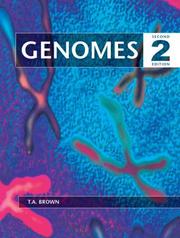
ISBN: 1859960294 1859962289 9781859960295 Year: 2002 Publisher: Oxford BIOS scientific publ.
Abstract | Keywords | Export | Availability | Bookmark
 Loading...
Loading...Choose an application
- Reference Manager
- EndNote
- RefWorks (Direct export to RefWorks)
Molecular biology --- Genomes --- Génomes --- Genome. --- Genomes. --- 575.113 --- 575 --- Gene. Genetic apparatus. Genome --- General genetics. General cytogenetics. Immunogenetics. Evolution. Speciation. Phylogeny --- 575 General genetics. General cytogenetics. Immunogenetics. Evolution. Speciation. Phylogeny --- 575.113 Gene. Genetic apparatus. Genome --- Génomes --- Genome
Book
ISBN: 013347559X 0133475425 9780133475425 9780133475593 Year: 1969 Publisher: Englewood Cliffs Prentice Hall
Abstract | Keywords | Export | Availability | Bookmark
 Loading...
Loading...Choose an application
- Reference Manager
- EndNote
- RefWorks (Direct export to RefWorks)
Proteins --- 575.113 --- Molecular genetics --- Proteids --- Biomolecules --- Polypeptides --- Proteomics --- Genetics --- Molecular biology --- Gene. Genetic apparatus. Genome --- Molecular genetics. --- Proteins. --- Basic Sciences. Genetics --- Genetics (General) --- Genetics (General). --- 575.113 Gene. Genetic apparatus. Genome
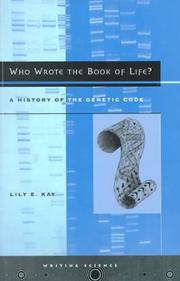
ISBN: 0804733848 0804734178 9780804733847 Year: 2000 Publisher: Stanford Stanford university press
Abstract | Keywords | Export | Availability | Bookmark
 Loading...
Loading...Choose an application
- Reference Manager
- EndNote
- RefWorks (Direct export to RefWorks)
Genetic code
---
Research
---
History
---
575.113
---
-#BIBC:ruil
Book
ISBN: 0126146500 0323151140 9780126146509 Year: 1972 Publisher: New York (N.Y.): Academic press
Abstract | Keywords | Export | Availability | Bookmark
 Loading...
Loading...Choose an application
- Reference Manager
- EndNote
- RefWorks (Direct export to RefWorks)
Cytoplasmic inheritance --- Mitochondria --- Chloroplasts --- 576.311 --- Chloroplastids --- Chromatophores --- Plastids --- Chondriosomes --- Protoplasm --- Cytoplasmic heredity --- 576.311 Cytoplasm --- #WPLT:dd.prof.J.Vendrig --- 575.113 --- Cell organelles --- Cytogenetics --- Heredity --- 575.113 Gene. Genetic apparatus. Genome --- Gene. Genetic apparatus. Genome --- Cytoplasm
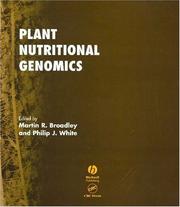
ISBN: 1405121149 0849323622 Year: 2005 Publisher: Oxford Blackwell
Abstract | Keywords | Export | Availability | Bookmark
 Loading...
Loading...Choose an application
- Reference Manager
- EndNote
- RefWorks (Direct export to RefWorks)
Plants --- Plantes --- Nutrition --- Genetic aspects --- Alimentation --- Aspect génétique --- 581.133 --- 575.113 --- 575.113 Gene. Genetic apparatus. Genome --- Gene. Genetic apparatus. Genome --- 581.133 Assimilation of other substances by autotrophic plants --- Assimilation of other substances by autotrophic plants
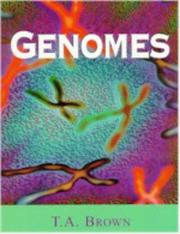
ISBN: 1859962017 9781859962015 Year: 1999 Publisher: Oxford BIOS scientific publ.
Abstract | Keywords | Export | Availability | Bookmark
 Loading...
Loading...Choose an application
- Reference Manager
- EndNote
- RefWorks (Direct export to RefWorks)
GENOMES is a revolutionary new textbook for undergraduates in genetics and molecular biology.; ; Genome sequencing is engendering a major change in molecular biology where the genome, not the gene, is the central unit of genetics.
Molecular biology --- genomen (geneeskunde) --- Genomes. --- Génomes --- genomes --- Carte génétique --- genetic maps --- Génie génétique --- genetic engineering --- Protéine de liaison --- Binding proteins --- ADN --- DNA --- ARN --- RNA --- Réplication --- replication --- Biologie moléculaire --- Biochimie --- biochemistry --- Phylogénie --- Phylogeny --- 575.113 --- #ABIB:aimm --- Genetica --- Genomen --- Gene. Genetic apparatus. Genome --- 575.113 Gene. Genetic apparatus. Genome --- Génomes --- moleculaire biologie --- DNA. --- RNA. --- replication. --- Molecular Biology. --- Molecular Biology --- Genes --- Genome, human --- Proteome
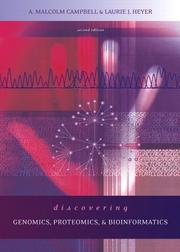
ISBN: 0805382194 9780805382198 Year: 2007 Publisher: San Francisco (Calif.) Benjamin/Cummings
Abstract | Keywords | Export | Availability | Bookmark
 Loading...
Loading...Choose an application
- Reference Manager
- EndNote
- RefWorks (Direct export to RefWorks)
genetica --- Genetics --- Genomics --- Proteomics --- Bioinformatics --- Génomique --- Protéomique --- Bio-informatique --- 575.113 --- Gene. Genetic apparatus. Genome --- 575.113 Gene. Genetic apparatus. Genome --- Génomique --- Protéomique --- Molecular biology --- Proteins --- Genome research --- Genomes --- Molecular genetics --- Bio-informatics --- Biological informatics --- Biology --- Information science --- Computational biology --- Systems biology --- Research --- Data processing
| Listing 1 - 10 of 52 | << page >> |
Sort by
|

 Search
Search Feedback
Feedback About
About Help
Help News
News